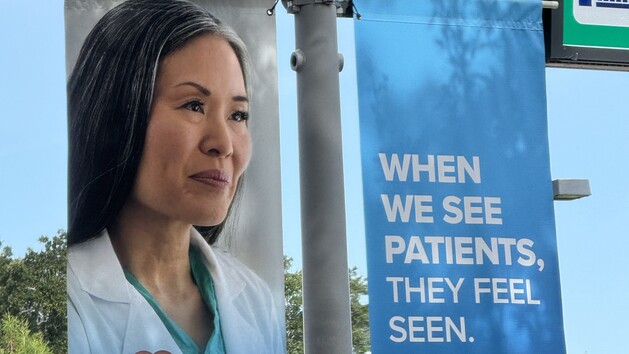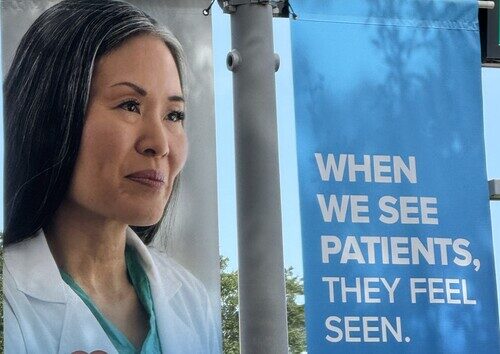15 April 2025 | St Albans [David Neal]
In this third instalment of the Character-Driven Leaders series for TedNEWS, we explore why equality and inclusivity lie at the heart of authentic Christian leadership.”
AdventHealth® has an excellent reputation as a US hospital system. Known for its strong medical outcomes and patient care, one of its promotional banners resonates with me, and I can’t get it out of my mind.

Why can’t the church be more like the hospital?
Seeing those words on the lampost banner, I moved the context from the hospital to church in a nanosecond! As a church leader, can I say authentically, “When I see members and guests at worship, do they feel seen?” Do those around the table feel seen when I lead boards and committees? Do they feel seen in my pastoral care to Mr Smith or Mrs Jones?
If there is one value about the UK National Health Service that outshines all other healthcare systems, it is the provision of care according to need, not wealth. No one is ever turned away from a UK hospital for lack of funds or identity. All are treated equitably, without distinction to class, status, ethnicity, race, culture, sexual identity, gender orientation, or any other label. The value says: our door is open, your need is seen, come as you are—we’ll journey with you to make you whole.
The Fortress Church
In contrast, while the church shares the same value in the name of Christ, the reality is sometimes different:
In Values-Led Lives, Llew Edwards tells the story of a pastor whose son had drifted from the church and his roots. Now living far away, the pastor accepted a preaching appointment at a church in his son’s town. Days before, he messaged his son to say he’d preach at New Street church. Receiving no reply, he travelled there that Sabbath morning, full of hope that he and his wife might connect with their son in church.
As worship began, he felt disappointed that his son hadn’t arrived—especially with Dad in town! Still, he set it aside to focus on his message. During the first hymn, he glimpsed through the church window, and his heart skipped a beat: his son and girlfriend were walking toward the entrance. Overjoyed, the pastor’s heart burned with confidence that the Lord had answered his prayer. But something strange happened. As worship continued, they never appeared—and by the end, still no sign. Curious, he asked someone in the foyer if they’d seen a couple enter. “Oh yes,” they said, “the girl wore a mini-skirt, not suitably dressed for worship—so we told them to come back another time.”
When Zac didn’t want to be seen
The gospels offer many examples of people Jesus noticed in his ministry, including the least, the last, and the lost. N.T. Wright suggests that Jesus’ table fellowship with sinners was not just a social gesture but a deep theological statement about who was in and who was out in God’s renewed Israel. (1) Someone who thought he was definitely ‘out’ was Zacchaeus, so much so that he didn’t want to be seen.

Running ahead of the crowd, he spotted a sycamore tree and climbed it—pleased with his grandstand view, about 15 feet up: close enough to see, high enough to stay unnoticed. As the crowd stopped—right under the tree, Zac’s heart raced, and the pit in his small stomach grew. He froze—this wasn’t the plan. For a few moments, Jesus kept talking and blessing the children. Just as Zac thought things were under control, Jesus looked up. ‘Hello, Zac! What are you doing up there? Want to do tea? You don’t live far, do you?’ Zac scrambled down—almost jumped—and landed before Jesus, no bones broken. Jesus smiled and said, ‘Come on—let’s go.’
Zac’s ego soared! For possibly the first time, his height didn’t matter. He was so absorbed in conversation with Jesus that he didn’t notice the crowd grumbling. At his house, they went inside while the crowd waited outside.
Not only was Zac a tax collector – he was the chief tax collector. In Jericho, at this time, it seems that tax was not collected PAYE (pay as you earn), but PWID (pay what I demand) – as and WIDI (when I demand it)! Zac was more than successful in his job; he was wealthy, but wealthy due to theft and fraud.
Over tea, Jesus said, ‘Things haven’t been going well, have they?” Zac’s bubble burst. “No”, he replied. “I’m lonely, frightened, and scared. Everybody hates me, and I can’t stand it. I feel so much pain. Do you know what that’s like? I want to be loved.”

And Jesus listened. And shared with Zac the truth about what the Kingdom of God is really like – and listened again. The crowd said: “He has gone in to be the guest of a man who is a sinner.” (Luke 19:7). Zac said: “Behold, Lord, the half of my goods I give to the poor. And if I have defrauded anyone of anything, I restore it fourfold.” (Luke 19:8,) And Jesus said: “Today salvation has come to this house since he also is a son of Abraham. For the Son of Man came to seek and to save the lost.” (Luke 18:9, 10)
Present but Absent
Harry is a new Adventist, still growing in his faith and unable to navigate all the customs and norms of Adventism. He relates to Philip Yancey’s perspective that “Church is where I bring my doubts, my loneliness, my spiritual fatigue—not to fix them, but to offer them. To lay them down. Even when I’m numb. Even when I feel nothing.” As he enters the church foyer, Harry likes the warm “Welcome—happy sabbath, and how are you today?” greeting, but he knows it’s not the place to reveal his internal struggles. During worship, he’s physically present, going through the motions—standing, singing, praying, and listening to the sermon—but while he notices the warmth around him, it doesn’t seem to reach him. As he describes it, “It’s like being invisible in plain sight—present but disconnected, unsure of where or how I fit in.” He is also challenged by the complexity of the in-house language used by those who lead worship, including the pastor. After worship, Harry accepts an invitation to fellowship lunch. While he observes conversations around him, they don’t seem to include him, and he feels awkward as he tries to engage. He wonders if this church comprises two distinct groups: the “insiders” and the “outsiders.”

Equal and Inclusive
Back in Paul’s day, the church really struggled with inclusion. Tensions existed around ethnicity and religion, gender roles, leadership, worship styles, social status, freedom, wealth and poverty, and how to care for widows and others who were vulnerable. But along comes Paul with a value that blows apart the existing structures and tensions.
“There is neither Jew nor Greek,
there is neither slave nor free,
there is no male and female,
for you are all one in Christ Jesus.”
(Galatians 3:28).
Call it the heartbeat of his vision or the manifesto for God’s new society; it was countercultural to the core. No longer does social hierarchy determine status; there is a new community where ethnicity, class, and gender matter not. The key to this new community? The ‘In Christ’ experience (referred to 90 times by Paul) breaks down the walls of separation from God and those in society. This was radical!

Equal and Inclusive?
We talk a lot about equality and inclusion in the church. But as many preachers will say colloquially, “Do we walk the talk?” Choose your first-century challenge Paul faced in the church regarding inclusion, but if we are to get from where we are – to where we should be, it will take nothing less than Adventist leaders who have these values of the gospel embedded in their character.
“Who needs a doctor: the healthy or the sick?
I’m here inviting outsiders, not insiders –
an invitation to a changed life, changed inside and out.”
(Luke 5:31-32 Msg)
Featured image: David Neal
Photos: Shutterstock and David Neal
Unless noted, all scripture references are from the English Standard Version.
- https://ntwrightpage.com/1985/01/01/jesus-israel-and-the-cross/?utm_source=chatgpt.com
Want to discover more about character-driven leadership? “Today’s Leader 50 Timeless Leadership Principles”, a collaborative work by David Neal, Don W. McFarlane, and Josney Rodriguez considers the ageless principles of leadership that the twenty-first century may have forgotten. Published by Stanborough Press, the book is available through Life Source Christian Bookshop



